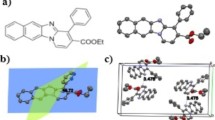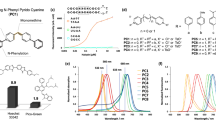Abstract
Spectral-fluorescent properties of benzothiazole styryl monomer (Bos-3) and homodimer (DBos-21) dyes in presence of DNA were studied. The dyes enhance their fluorescence intensity in 2–3 orders of magnitude upon interaction with DNA. Studied styrylcyanines in DNA presence demonstrate rather high values of two-photon absorption (TPA) cross-section, which are comparable with the values of TPA cross section of the rhodamine dyes. An applicability of the styrylcyanines as probes for the fluorescence microscopy of living cells was studied. It was shown that both dyes are cell-permeable but homodimer dye DBos-21 produces noticeably brighter staining of HeLa cells comparing with monomer dye Bos-3. Molecules of DBos-21 initially bind to the nucleic acids- containing cell organelles (presumable mitochondria) and are able to penetrate into the cell nucleus. Thus, homodimer styryl DBos-21 dye is viewed as efficient stain for single-photon and two-photon excitation fluorescence imaging of living cells.








Similar content being viewed by others
References
Haughland R (2002) Molecular probes. Handbook of fluorescent probes and research chemicals, 9th edn. Molecular Probes Inc., Eugene
Albota M, Beljonne D, Brédas J-L, Ehrlich JE, Fu J-Y, Heikal AA, Hess SE, Kogej T, Levin MD, Marder SR, McCord-Maughon D, Perry JW, Röckel H, Rumi M, Subramaniam G, Webb WW, Wu X-L, Xu C (1998) Design of organic molecules with large two-photon absorption cross sections. Science 281(5383):1653–1656. doi:10.1126/science.281.5383.1653
Xu C, Webb WW (1996) Measurement of two-photon excitation cross-sections of molecular fluorophores with data from 690 nm to 1050 nm. J Opt Soc Am B 13(3):481–491. doi:10.1364/JOSAB.13.000481
Bradley DJ, Hutchinson MHR, Koetser H (1972) Interaction of picosecond laser pulses with organic molecules II: two-photon absorption cross sections. Proc R Soc Lond A 329(1576):105–119. doi:10.1098/rspa.1972.0103
Albota MA, Xu C, Webb WW (1998) Two-photon fluorescence excitation cross-sections of biomolecular probes from 690 to 960 nm. Appl Opt 37(31):7352–7356. doi:10.1364/AO.37.007352
Albota M, Beljonne D, Brédas J-L, Ehrlich JE, Fu J-Y, Heikal AA, Hess SE, Kogej T, Levin MD, Marder SR, McCord-Maughon D, Perry JW, Röckel H, Rumi M, Subramaniam G, Webb WW, Wu X-L, Xu C (1998) Design of organic molecules with large two-photon absorption cross sections. Science 281(5383):1653–1656. doi:10.1126/science.281.5383.1653
Fischer A, Cremer C, Stelzer EHK (1995) Fluorescence of coumarins and xanthenes after two-photon absorption with a pulsed titanium-sapphire laser. Appl Opt 34(12):1989–2003. doi:10.1364/AO.34.001989
Tian L, Hu Z, Shi P, Zhou H, Wu J, Tian Y, Zhou Y, Tao X, Jiang M (2007) Synthesis and two-photon optical characterization of D-π-D type Schiff bases. J Lumin 127:423–430. doi:10.1016/j.jlumin.2007.02.040
Fu J, Padilha LA, Hagan DJ, Van Stryland EW, Przhonska OV, Bodnar MV, Slominsky YL, Kachkovski AD (2007) Experimental and theoretical approaches to understanding two-photon absorption spectra in polymethine and squaraine molecules. J Opt Soc Am B 24(1):56–66. doi:10.1364/JOSAB.24.000056
Fu J, Padilha LA, Hagan DJ, Van Stryland EW, Przhonska OV, Bodnar MV, Slominsky YL, Kachkovski AD (2007) Molecular structure—two-photon absorption property relations in polymethine dyes. J Opt Soc Am B 24(1):67–76. doi:10.1364/JOSAB.24.000067
Ahn TK, Kim KS, Kim DY, Noh SB, Aratani N, Ikeda C, Osuka A, Kim D (2006) Relationship between two-photon absorption and the π-conjugation pathway in porphyrin arrays through dihedral angle control. J Am Chem Soc 128:1700–1704. doi:10.1021/ja056773a
Huang Z-L, Lei H, Li N, Qiu Z-R, Wang H-Z, Guo J-D, Luo Y, Zhong Z-P, Liu X-F, Zhou Z-H (2003) Novel heterocycle-based organic molecules with two-photon induced blue fluorescent emission. J Mater Chem 13:708–711. doi:10.1039/b300924f
Reinhardt BA, Brott LL, Clarson SJ, Dillard AG, Bhatt JC, Kannan R, Yuan L, He GS, Prasad PN (1998) Highly active two-photon dyes: design, synthesis, and characterization toward application. Chem Mater 10:1863–1874. doi:10.1021/cm980036e
Kim O-K, Lee K-S, Woo HY, Kim KS, He GS, Swiatkiewicz J, Prasad PN (2000) New class of two-photon absorbing chromophores based on dithienothiophene. Chem Mater 12:284–286. doi:10.1021/cm990662r
So PTC, Dong CY, Masters BR, Berland KM (2000) Two-photon excitation fluorescence microscopy. Annu Rev Biomed Eng 2:399–429. doi:10.1146/annurev.bioeng.2.1.399
Ohulchanskyy TY, Pudavar HE, Yarmoluk SM, Yashchuk VM, Bergey EG, Prasad PN (2003) A monomethine cyanine dye Cyan 40 for two-photon-excited fluorescence detection of nucleic acids and their visualization in live cells. Photochem Photobiol 77(2):138–145. doi:10.1562/0031-8655(2003) 077<0138:AMCDCF>2.0.CO;2
Van Orden A, Cai H, Goodwin PM, Keller RA (1999) Efficient detection of single DNA fragments in flowing sample streams by two-photon fluorescence excitation. Anal Chem 71:2108–2116. doi:10.1021/ac9811221
Fujita H, Nakano M, Takahata M, Yamaguchi K (2002) A new strategy of enhancing two-photon absorption in conjugated molecules: introduction of charged defects. Chem Phys Lett 358:435–441. doi:10.1016/S0009-2614(02)00674-7
Wu L-Z, Tang X-J, Jiang M-H, Tung C-H (1999) Two-photon induced fluorescence of novel dyes. Chem Phys Lett 315:379–382. doi:10.1016/S0009-2614(99)01118-5
Kovalska VB, Kryvorotenko DV, Balanda AO, Losytskyy MY, Tokar VP, Yarmoluk SM (2005) Fluorescent homodimer styrylcyanines: synthesis and spectral-luminescent studies in nucleic acids and protein complexes. Dyes Pigments 67:47–54. doi:10.1016/j.dyepig.2004.10.007
Tokar VP, Losytskyy MY, Kovalska VB, Kryvorotenko DV, Balanda AO, Prokopets VM, Galak MP, Dmytruk IM, Yashchuk VM, Yarmoluk SM (2006) Fluorescence of styryl dyes-DNA complexes induced by single- and two-photon excitation. J Fluoresc 16(6):783–791. doi:10.1007/s10895-006-0127-3
Akbay N, Losytskyy MY, Kovalska VB, Balanda AO, Yarmoluk SM (2008) The mechanism of benzothiazole styrylcyanine dyes binding with dsDNA: studies by spectral-luminescent methods. J Fluoresc 18(1):139–147. doi:10.1007/s10895-007-0252-7
Losytskyy MY, Akbay N, Kovalska VB, Balanda AO, Boutorine A, Yarmoluk SM (2007) To the studies of (p-dimethylaminostyryl)pyridinium based homodimer to dsDNA binding mechanism. Ukrainica Bioorganica Acta 5(2):52–55
Yashchuk VM, Kudrya VY, Losytskyy MY, Tokar VP, Yarmoluk SM, Dmytruk IM, Prokopets VM, Kovalska VB, Balanda AO, Kryvorotenko DV, Ogul'chansky TY (2007) The optical biomedical sensors for DNA detection and imaging based on two-photon excited luminescent styryl dyes: phototoxic influence on the DNA. Proc. SPIE 6796, 67960M, 14 p
Zheng Q, Ohulchanskyy TY, Sahoo Y, Prasad PN (2007) Water-dispersible polymeric structure co-encapsulating a novel hexa-peri-hexabenzocoronene core containing chromophore with enhanced two-photon absorption and magnetic nanoparticles for magnetically guided two-photon cellular imaging. J Phys Chem C 111(45):16846–16851. doi:10.1021/jp074713g
Kim S, Ohulchanskyy TY, Pudavar HE, Pandey RK, Prasad PN (2007) Organically modified silica nanoparticles co-encapsulating photosensitizing drug and aggregation-enhanced two-photon absorbing fluorescent dye aggregates for two-photon photodynamic therapy. J Am Chem Soc 129(9):2669–2675. doi:10.1021/ja0680257
Cinteza LO, Ohulchanskyy TY, Sahoo Y, Bergey EJ, Pandey RK, Prasad PN (2006) Diacyllipid micelle-based nanocarrier for magnetically guided delivery of drugs in photodynamic therapy. Mol Pharm 3(4):415–423. doi:10.1021/mp060015p
Acknowledgement
The work was supported by the Science and Technology Center in Ukraine (grant # U3104k). We are grateful to the National Academy of Sciences of Ukraine (NASU) for providing us with possibility to use the “Laser Femtosecond Complex” at the Institute of Physics of NASU.
Author information
Authors and Affiliations
Corresponding author
Rights and permissions
About this article
Cite this article
Tokar, V.P., Losytskyy, M.Y., Ohulchanskyy, T.Y. et al. Styryl Dyes as Two-Photon Excited Fluorescent Probes for DNA Detection and Two-Photon Laser Scanning Fluorescence Microscopy of Living Cells. J Fluoresc 20, 865–872 (2010). https://doi.org/10.1007/s10895-010-0630-4
Received:
Accepted:
Published:
Issue Date:
DOI: https://doi.org/10.1007/s10895-010-0630-4




